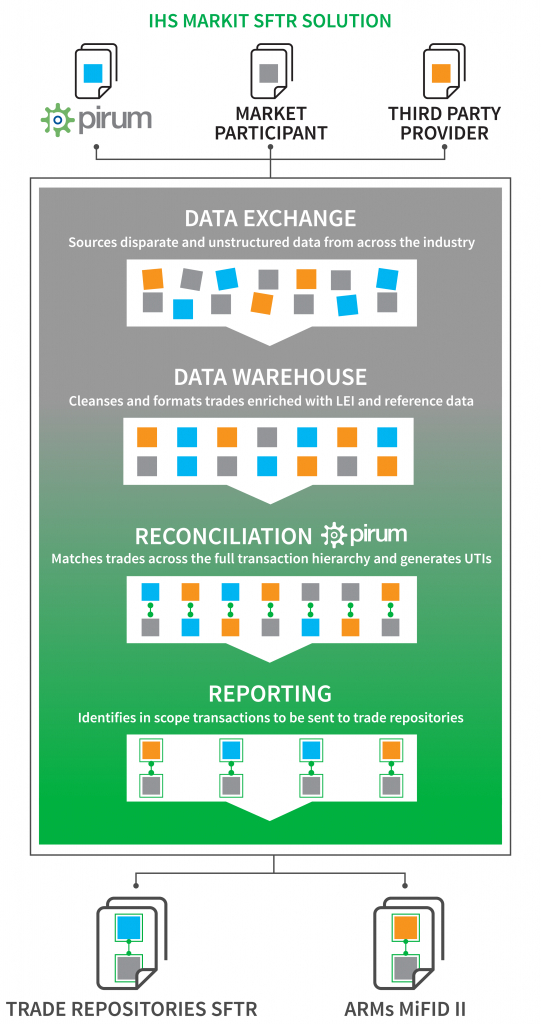The need for systems and processes in collateral management and securities finance to seamlessly work together has led to increased co-operation between service providers. Most major providers now offer at least some degree of integration with complementary systems. With market and regulatory pressures intensifying on their customers, we are now seeing the creation of formal partnerships to provide the joined-up solutions the industry needs. Pirum is leading this effort on multiple fronts.
Collaboration has become increasingly necessary
Securities finance and collateral management are areas in financial markets that have benefitted from the choice of a range of service providers and products with functionality varying in richness and maturity. However, most products originated in business or functional silos. Repo and securities lending trading systems typically originated before developments to support both products, not always successfully. Many collateral management systems were originally built to support one area of inventory management (e.g. OTC derivatives) and later expanded to support a wider range of products (e.g. repo and stock loan). In addition to core system offerings, other services have evolved to fill the gaps created by the traditional and relatively complex bilateral OTC method of trading. Typically, these manage trade life cycle events requiring market and counterparty interaction, such as Pirum’s post-trade automation services.
The last decade has brought increased pressure from banks, the buy-side and regulators to streamline the business and remove functional silos. This has led in turn to increased demands on systems and internal IT departments to make key infrastructure more “joined-up”. Senior management in banks (and regulators) generally require a single view of collateral and more transparent business processes. This is seen as a more effective way to reduce counterparty, credit and operational risk. Virtually every significant trading decision now has an impact on leverage, liquidity, funding, RWA and ultimately P&L. Collateral management and trading desks must work more closely together to optimise the use of collateral and make it a consideration for trading decisions. Operations management, facing cost pressures, have attempted to increase efficiency through the consolidation and rationalisation of related teams and systems. This had led to continuing efforts to merge functions across collateral management, repo, securities lending, clearing, and non-cleared OTC derivatives and futures.
Market and regulatory trends are such that many of the traditional divisions between front and back office teams need to be removed. There has always been a greater degree of integration or at least blurring between front and back office in securities finance and collateral management compared to other products. It could be argued that in some markets repo and securities lending are starting to become more commoditised functions, whereas teams performing optimisation and collateral transformation have an increasingly important role within institutional hierarchies. This alternate landscape has resulted in changes to what services are being offered and to whom they are pitching in organisations.
As businesses evolve, it is of course important for service providers to ensure their offerings remain relevant. Clearly, building completely new software from scratch can be an expensive and risky enterprise. With banks and buy-side firms up against hard regulatory deadlines, there is a general desire to minimise the risk associated with systems that are not ready on time. Failure to comply with regulations could ultimately mean fines or businesses being forced to close.
How collaboration benefits clients
One practical way to minimise risk for both service providers and their clients is to create partnerships that allow entities to combine the individual strengths of their existing products to solve new challenges. Integration of functionality from existing systems, as well as combining expertise in complementary areas, is a way for providers to reduce cost, implementation risk, and time to market.
In recent years, there has been a notable shift in the way that banks and buy-side firms regard the buy versus build conundrum. Many institutions have come to the conclusion that shared problems are best dealt with by buying standard solutions from external providers rather than building their own solutions to non-differentiating areas. As SFTR and MiFID II come into view, firms have learned from their experiences of building solutions to meet OTC derivatives reporting requirements under the Dodd-Frank Act (DFA) and the European Market Infrastructure Regulation (EMIR). These were generally expensive to build and maintain, and still had major problems providing good quality data to Trade Repositories. Even buying a collection of best-of-breed solutions can create significant costs and risks for banks as individual systems and services require internal integration. Further, this integration often needs to be revisited each time one of the relevant systems is upgraded.
The unglamorous business of integration and upgrades is generally a major burden on internal IT departments and limits the time and budget for revenue generating projects. If a partnership can provide a seamlessly integrated and future proof solution to the problems that clients face, it means there is one less interface that an IT department needs to worry about. In these cost-conscious times, a holistic solution to a complex but standard set of problems that can simplify overall infrastructure is an attractive proposition and one that also offers a degree of future proofing.
How collaboration benefits service providers
Most providers want to provide a better and broader service to their clients and some, including Pirum, are starting to see partnerships as the best way of achieving this. The firms likely to form partnerships will have client bases that have some degree of overlap but are sufficiently diverse to create opportunities for both partners to get direct exposure to potential new clients and markets. The critical mass of established offerings in securities finance and collateral management makes it possible to find partners that have complementary skills, system functionality, and connectivity to clients. The right partner for the right problem can provide a wide range or benefits: from a detailed understanding of nuances across markets, to the most effective way to design a data model.
At a more strategic level, the increasing convergence between product lines in securities finance and collateral management means that in the long term there will be less scope for pure niche players. Partnerships are a great way to learn about the bigger picture and become ready for a more convergent world, and for service providers to quickly expand their functionality to become more relevant to a broader audience.
The Pirum example in SFTR reporting
A key challenge for markets over the next few years continues to be driven by regulation. Whereas previous regulatory changes had a major impact on profitability, the next wave will place specific demands on securities finance and collateral management, systems, architecture and operational processes.
A principal focus in 2017 is the European Union’s Securities Financing Transaction Regulation (SFTR). SFTR brings securities finance and collateral trades under the same general regime as OTC derivatives for reporting. It also places restrictions on the re-use of collateral and adds far more stringent requirements on record keeping. The regulation has been in the pipeline since 2013, but the final technical standards have only just been submitted to the European Commission for approval with reporting due to begin next year. Based on recent experiences with other reporting regulations, this is a very small window. Despite of the ongoing pain from EMIR and DFA OTC derivatives reporting, there is currently no obvious “plug and play” reporting solution for SFTR. Lacking a single solution, we were encouraged by our design partners and clients to work together.
Given this short time scale and in response to client demand, Pirum and IHS Markit have partnered on a robust SFTR solution. Pirum has many years’ experience in processing securities finance data through its real-time automation hub processing securities finance trades and collateral data. In addition, Pirum already has connectivity to many of the key players in securities finance. IHS Markit has a well-established Securities Finance Pricing Data service as well as direct experience connecting to trade repositories to report OTC derivative trades via its MarkitServ product. Together, it appeared that we have most of the pieces that a reporting firm needs for SFTR compliance and can deliver a pre-integrated service connectivity (see Exhibit 1). The Pirum-Markit partnership could be the first of many partnerships in this industry.
Exhibit 1: IHS Markit SFTR Solution

Source: Pirum
While SFTR is specific to Europe, the same general requirement is already applicable in the US as well. The Federal Reserve’s rule SR14-1 aims to make the process of recovery and resolution more straightforward for large bank holding companies. Unsurprisingly, this involves being able to demonstrate “Effective processes for managing, identifying, and valuing collateral it receives from and posts to external parties and affiliates;” as well as more specific record keeping requirements. Firms will also need to be able to demonstrate that the correct master agreement and CSA is assigned to each trade for Qualifying Financial Contracts (QFCs).
Globally, we see a continued need for collaboration by service providers in the securities finance and collateral management space. The requirement for new solutions is not going away; while regulations are still a focus, other opportunities will emerge in the future where banks and buy-side firms will look externally for companies provide a complete front-to-back, cross-product solution. As providers build on their strengths, reaching across the street to complementary or adjacent systems will offer all parties strategic new compliance or growth opportunities with reduced risk in the development and integration cycle.
 Phil Morgan is Head of Business Development at Pirum Systems. Previously, he was a Managing Director in Nomura’s Prime Finance business and had responsibility for Equity Finance, Delta 1 and Prime Brokerage in EMEA. After starting his career at Chemical Bank in 1996, he went on to hold several positions at J.P. Morgan, culminating in sales responsibility for their clearance & collateral management products (including tri-party). In 2007 Phil left JPM to join Lehman Brothers and ran Liquidity Sales across fixed income and equity, before joining Nomura following the integration of the Lehman business in October 2008. He holds a BSc (Hons) from Cardiff University.
Phil Morgan is Head of Business Development at Pirum Systems. Previously, he was a Managing Director in Nomura’s Prime Finance business and had responsibility for Equity Finance, Delta 1 and Prime Brokerage in EMEA. After starting his career at Chemical Bank in 1996, he went on to hold several positions at J.P. Morgan, culminating in sales responsibility for their clearance & collateral management products (including tri-party). In 2007 Phil left JPM to join Lehman Brothers and ran Liquidity Sales across fixed income and equity, before joining Nomura following the integration of the Lehman business in October 2008. He holds a BSc (Hons) from Cardiff University.


